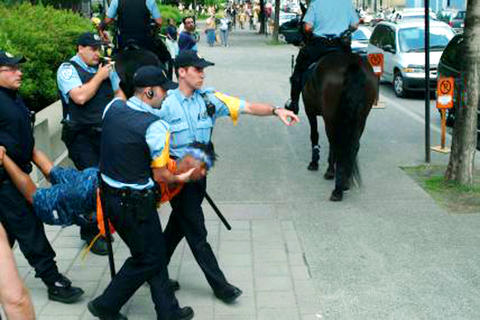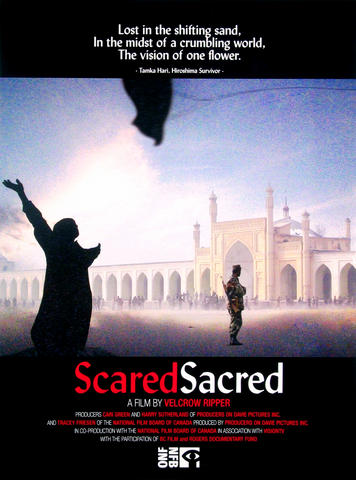In 1948, the General Assembly of the UN adopted the Universal Declaration of Human Rights, which called for the universal recognition of fundamental rights and freedoms of all human beings.
In the following 60 years, Israel, Palestine, the minefields of Cambodia, New York City and war-torn Afghanistan have been the "ground zeros" of the world, producing stories of destruction and survival that both dishearten and inspire.
Some of these stories will be revisited at the Canada Taiwan Human Rights Film Festival, which starts tonight at SPOT Taipei Film House (台北之家:光點電影院) and will also show in Hsinchu City and Kaohsiung County through June.

PHOTO: COURTESY OF THE CANADIAN TRADE OFFICE IN TAIPEI
The event was organized by the Canadian Trade Office in Taipei with curatorial assistance from the National Film Board of Canada, Taiwan Indigenous TV (台灣原住民族電視台) and the Public Television Service (公視). It will highlight the accomplishments and follies of humanity with a lineup of one fictional film and 13 documentaries from Canada and Taiwan. The movies will be grouped under themes ranging from Aboriginal movements and new immigrants to environmentalism and multiculturalism.
Aboriginal Rights Events in Taiwan (原運二、三事) and When Tribes Meet the Nation (當部落遇到國家) document Taiwan's Aboriginal rights movement. In a similar vein, Kanehsatake: 270 Years of Resistance is a powerful account of what has come to be known as the Oka Crisis. In the summer of 1990, the people from the Mohawk tribe stood up against the Quebec police and Canadian army to fight for their right to live on land that belonged to them and their ancestors.
Immigrants' rights are tackled in The Voyage to Happiness (幸福的地圖), which features interviews with female immigrant spouses in 14 Asian cities, including Taipei, Tokyo, Seoul and Ho Chi Minh City. The movie records their struggles to overcome cultural prejudice and earn basic rights.

PHOTO: COURTESY OF THE CANADIAN TRADE OFFICE IN TAIPEI
Just how deeply our prejudices are seated is revealed in Zero Tolerance, in which the lives of minority teenagers in the city of Montreal are portrayed as more difficult than their majority counterparts.
In There and Back, a teenage girl living in Canada learns to accept her double identity as a burden and a treasure after a two-month visit with her Iraqi father in Jordan. Director Paul Emile d'Entremont will hold a question-and-answer sessions after the screenings this weekend at SPOT.
The raging war between humans and nature is eloquently illustrated in Manufactured Landscapes, a documentary on Canadian artist Edward Burtynsky, who is known for photographing landscapes altered by factories, dams and scrap heaps. Following a trip by Burtynsky to China, the film reveals the rarely seen effects of the huge nation's industrial revolution, from the Three Gorges Dam to Shanghai's urban renewal plan. The Refugees of the Blue Planet takes a look at the little-known plight of environmental refugees who are displaced and forced to leave their traditional ways of life due to the degradation of the environment.

PHOTO: COURTESY OF THE CANADIAN TRADE OFFICE IN TAIPEI

That US assistance was a model for Taiwan’s spectacular development success was early recognized by policymakers and analysts. In a report to the US Congress for the fiscal year 1962, former President John F. Kennedy noted Taiwan’s “rapid economic growth,” was “producing a substantial net gain in living.” Kennedy had a stake in Taiwan’s achievements and the US’ official development assistance (ODA) in general: In September 1961, his entreaty to make the 1960s a “decade of development,” and an accompanying proposal for dedicated legislation to this end, had been formalized by congressional passage of the Foreign Assistance Act. Two

President William Lai’s (賴清德) March 13 national security speech marked a turning point. He signaled that the government was finally getting serious about a whole-of-society approach to defending the nation. The presidential office summarized his speech succinctly: “President Lai introduced 17 major strategies to respond to five major national security and united front threats Taiwan now faces: China’s threat to national sovereignty, its threats from infiltration and espionage activities targeting Taiwan’s military, its threats aimed at obscuring the national identity of the people of Taiwan, its threats from united front infiltration into Taiwanese society through cross-strait exchanges, and its threats from

Despite the intense sunshine, we were hardly breaking a sweat as we cruised along the flat, dedicated bike lane, well protected from the heat by a canopy of trees. The electric assist on the bikes likely made a difference, too. Far removed from the bustle and noise of the Taichung traffic, we admired the serene rural scenery, making our way over rivers, alongside rice paddies and through pear orchards. Our route for the day covered two bike paths that connect in Fengyuan District (豐原) and are best done together. The Hou-Feng Bike Path (后豐鐵馬道) runs southward from Houli District (后里) while the

March 31 to April 6 On May 13, 1950, National Taiwan University Hospital otolaryngologist Su You-peng (蘇友鵬) was summoned to the director’s office. He thought someone had complained about him practicing the violin at night, but when he entered the room, he knew something was terribly wrong. He saw several burly men who appeared to be government secret agents, and three other resident doctors: internist Hsu Chiang (許強), dermatologist Hu Pao-chen (胡寶珍) and ophthalmologist Hu Hsin-lin (胡鑫麟). They were handcuffed, herded onto two jeeps and taken to the Secrecy Bureau (保密局) for questioning. Su was still in his doctor’s robes at